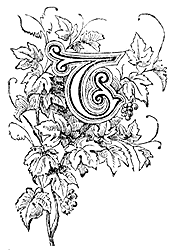 |

HORNTON Abbey is a noble object seen from the railway. It must, in its best days, have been a splendid structure. It originally consisted of a large quadrangular building surrounded by a deep ditch and an exceedingly high rampart. These defences were greatly required, for pirates from the Humber and the German Ocean constantly attacked the monastic buildings near the sea. Its architecture was consequently a singular mixture of the ecclesiastical and castellated styles, caused by this necessity of defence. The fine gatehouse on the west, forming the only entrance, is nearly entire; it is a fine building and well calculated for defensive purposes. Probably here the vassals of the abbey have contended desperately with the piratical hordes who found their richest spoil in the monasteries.
The architecture of this gatehouse is late Perpendicular, and it still has a barbican, battlements, loopholes, and embattled parapets, terminating in two strong round towers between which there was formerly a drawbridge.
The grand entrance-arch has a parapet over it, a small doorway from which leads to a cell, that was, probably, the watchman's lodge; in the entrance are the grooves of the decayed portcullis, and fragments of two ponderous doors. The western face of this entrance has six embattled turrets rising to the summit; between the two middle ones are three statues; the centre one wears a royal crown, the next is in armour, the third figure is mitred with a pastoral staff; each stands under an enriched canopy. They probably represent the Army and Church supporting the Crown. Above these are some small figures kneeling, and other niches in this front have doubtless contained statues.
In the interior, on the first floor is the grand banqueting room, its bay window has the stonework still entire. Here, in 1541, the community entertained Henry VIII. and Queen Jane Seymour; for King Henry, - on his return from a journey to the north, with his queen and retinue, - had crossed the Humber from Hull to Barrow, and honoured the Abbey of Thornton with a visit. The whole monastery had come out in solemn procession to meet the royal guests, and sumptuously entertained them for several days. Henry did not forget the flattering attentions paid him by the loyal brotherhood, and when the dissolution of the monasteries was decided on, the greater part of the revenues of Thornton Abbey was preserved for the endowment of a college here. Probably the monks had exhibited much erudition to the learned Tudor, and he meant both to reward them, and use their knowledge for educational purposes.
In the next reign it was suppressed, yet some of its members, even then, received pensions.
But we have wandered from our description of the ruins. The cells, chambers, and passages of the interior are very numerous and interesting. The chapter-house and the abbot's lodgings remain; the former is a most beautiful ruin. Eastward of the entrance the remains of the magnificent church have been excavated.
In taking down a wall in the abbey, a recess was found containing a human skeleton, a table, books, and a candlestick. It is supposed to be the skeleton of the fourteenth abbot, who was for some crime sentenced to be immured; that is, buried alive within the wall. Was his crime reading the works of the Reformers, and acknowledging his belief in their doctrines ? It may have been so, as other crimes were rarely so severely punished.
The abbey was founded in 1139 by William Fitz Odo, surnamed the Gros, as a priory of Black Canons. It was dedicated to the Virgin Mary. William le Gros died in 1180, and is supposed to have been buried here. The site of the abbey adjoins the parish of Thornton-Curtis, about five miles from Barton-on-Humber.
The monastery was first ruled by Prior Richard, who, with the monks, came from the monastery of Kirkham. It continued a priory for a short period, but having been endowed with many splendid grants, it was made an abbey.
Thornton was part of the estates of Henry Percy, first Earl of Northumberland, the father of Hotspur, who was slain at Bramham Moor, 14078, after a severe struggle with Henry IV.'s troops.
His head, white with age, was cut off and set upon London Bridge on a pole; and the four quarters of his body were set on the gates of London, Lincoln, Berwick-on-Twed, and Newcastle-on-Tyne. But in the May following they were taken down and interred.
Hotspur's son, after his father's death at the battle of Shrewsbury, was carried to Scotland, where he was brought up, but receiving, in after years, a pardon from the king through the intercession of Henry IV.'s half-sister Joan, he returned and was restored to his estates. Thornton thus became again the property of the Percies.
Thornton Abbey has passed to several other owners by purchase since that time; one of whom cut down a stately avenue of trees that extended from the gateway nearly to the church ; but upon the whole the ruins have been well preserved.
|
 |